#18th Century Inspired Costume
Text

Embroidery _Skirt Border, 1700s, Greek; Crete
Frieze of vases of carnations, interspersed with flowers, snakes, birds, double-headed eagles, floral scroll border
#dianthus#carnation#inspiration#embroidery#floral ornament#floral pattern#18th century costume#18th century art#greek art
2 notes
·
View notes
Text
As some of you may know, sewing is a big hobby of mine but after my last 2 relationships I felt really self conscious about wearing the clothes I made after nn ex insisted the dresses make me look pregnant and that he is embarrassed being seen with me dressed so oddly (most of my clothes are history bound). Add weight gain into the mix and I couldn't put it on and I was so sad about it. I had so many pretty clothes sitting in the box and more fabrics to turn into clothes and now it was there, unused.
Then my friend gave me a wonderful advice I would like to share with you: "These things take so much time to make. You don't feel comfortable wearing it now but one day, someone who loves you the way you are will come in and you will want ti put it on again and go on dates with them. Then you won't have time to make it and you will be so glad you have it. So make it now, take it as a preparation and research for future projects."
And so now I am sewing and designing again and I am enjoying the process. I made some really beautiful stuff since then, including a copy of Edith's dressing gown from the Crimson Peak.
Some days I feel like a maiden preparing her wardrobe for when she gets married and it makes me laugh so hard.
Some days my students ask me something and I bring them 18th century stays or a 1890s corset and they get to feel it and see how it worked and they are so fascinated to see that history was different to what they are taught. My girl students marvel at Victorian pockets and are amazed at how wonderfully adjustable 18th century clothes is. And that makes me happy as well, that even if I do not wear it, I can show it to kids and help them shape better image of how people might have lived in the past.
So if you like me, struggle with body image issues and dont feel confident enough to wear your clothes now, it is OK. You are still learning so sewing it is worth it. And one day, when you are ready, you will be so glad to have done the work that you can enjoy now.
#sewing#costuming#historical sewing#historical dress#historical costume#18th century costume#18th century stays#18th century dress#18th century#victorian dress#1890s dress#corset#corsetry#stays#sewing corset#inspiration#body image issues
2 notes
·
View notes
Text
might actually liveblog a craft project again over the coming months... stay tuned
#🫀#itll be an 18th century french inspired menswear ensemble#but with some vampire vibes#theres a vampire ball that happens every fall near me and i cannot afford to go this year but im hoping to catch it next year!#and also i want a halloween costume and something for ren faires now that i have time to do such things again#gonna try to get something that can serve triple duty so i can justify actually sinking money and time into it#i havent sketched out a full design yet but ive got some concepts and the linen for the shirt should be arriving. soon. idk when exactly bu#the shirt doesnt need anything super special about it anyway so its fine to make before i design everything#definitely going to take many months to get thru everything bc im planning lots of hand-sewing#and i need to space purchases out a lot anyway so i can afford decent fabric#but ya!! im finishing a live2d rig as a personal project n then maybe have a commission and after that i'll probably start the shirt#excited to take on something long-term again#and ive been itching to do something 18th century french inspired for years and years
3 notes
·
View notes
Photo

Joseph Wright of Derby (1734-1797) (attributed to), Portrait of the artist, wearing a red fur-collared coat and turban, oil on canvas, 65.1 x 55.6 cm, sold at Sotheby’s (Old Masters Day Sale/Lot 190 (2018?))
Source: Wikimedia Commons | Sotheby’s
#this outfit!!!#look at this coat!#the red!#matching the colour of his lips!#he's beautiful!#sorry for being unreasonably excited about this#but i love this#according to the information on Sotheby's website his outfit's inspired by#Hungarian style 'hussar' costumes#which were fashionable in the late 1760s and early 1770s#art#painting#portrait#artist's portrait#artist's self-portrait#18th century#18th century painting#18th century portrait#18th century fashion#historical fashion#historical menswear#turban#coat#male portrait#joseph wright#joseph wright of derby
2 notes
·
View notes
Note
Please can you explain the difference of meaning between hanfu and huafu ? Sorry if you already got the question
Hi, thanks for the question, and sorry for taking ages to reply! (hanfu photo via)
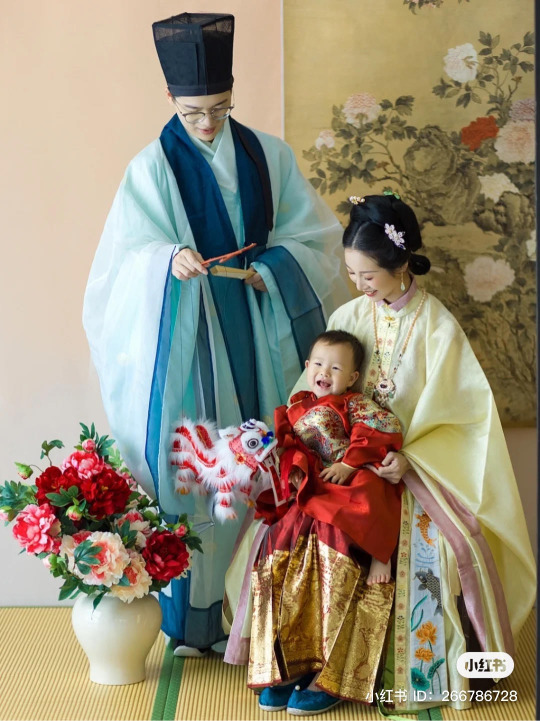
The term “hanfu” (traditional Chinese: 漢服, simplified Chinese: 汉服) literally means “Han clothing”, and refers to the traditional clothing of the Han Chinese people. “Han” (漢/汉) here refers to the Han Chinese ethnic group (not the Han dynasty), and “fu” (服) means “clothing”. As I explained in this post, the modern meaning of “hanfu” is defined by the hanfu revival movement and community. As such, there is a lot of gatekeeping by the community around what is or isn’t hanfu (based on historical circumstances, cultural influences, tailoring & construction, etc). This isn’t a bad thing - in fact, I think gatekeeping to a certain extent is helpful and necessary when it comes to reviving and defining historical/traditional clothing. However, this also led to the need for a similarly short, catchy term that would include all Chinese clothing that didn’t fit the modern definition of hanfu -- enter huafu.
The term “huafu” (traditional Chinese: 華服, simplified Chinese: 华服) as it is used today has a broader definition than hanfu. “Hua” (華/华) refers to the Chinese people (中华民族/zhonghua minzu), and again “fu” (服) means “clothing”. It is an umbrella term for all clothing that is related to Chinese history and/or culture. Thus all hanfu is huafu, but not all huafu is hanfu. Below are examples of Chinese clothing that are generally not considered hanfu by the hanfu community for various reasons, but are considered huafu:
1. Most fashions that originated during the Qing dynasty (1644–1911), especially late Qing, including the Qing aoqun & aoku for women, and the Qing changshan and magua for men. I wrote about whether Qing dynasty clothing can be considered hanfu here. Tangzhuang, which is an updated form of the Qing magua popularized in 2001, can also fit into this category. Below - garments in the style of Han women’s clothing during the Qing dynasty (清汉女装) from 秦綿衣莊 (1, 2).
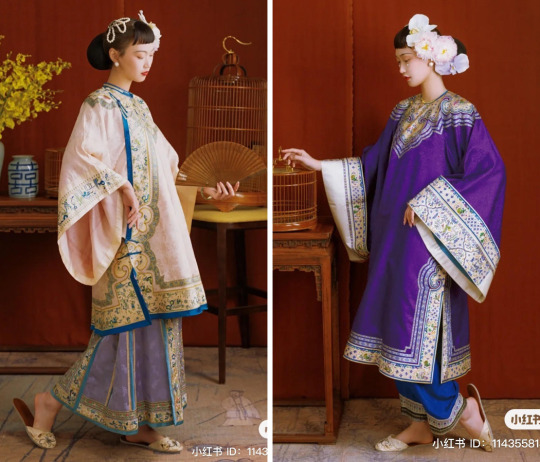
2. Fashions that originated during the Republican era/minguo (1912-1949), including the minguo aoqun & aoku and qipao/cheongsam for women, and the minguo changshan for men (the male equivalent of the women’s qipao). I wrote about why qipao isn’t considered hanfu here. Below - minguo aoqun (left) & qipao (right) from 嬉姷.

Below - Xiangsheng (crosstalk) performers Zhang Yunlei (left) & Guo Qilin (right) in minguo-style men’s changshan (x). Changshan is also known as changpao and dagua.
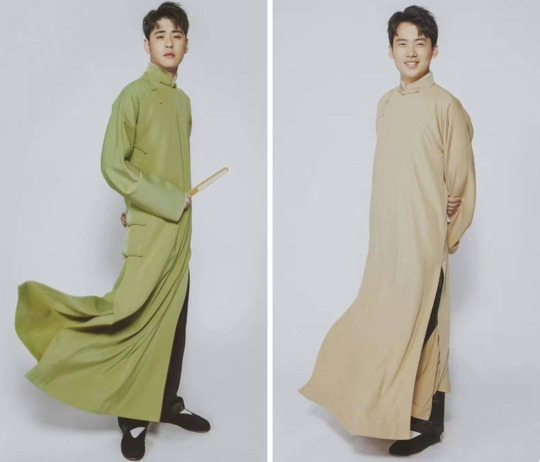
3. Qungua/裙褂 and xiuhefu/秀禾服, two types of Chinese wedding garments for brides that are commonly worn today. Qungua originated in the 18th century during the Qing dynasty, and xiuhefu is a modern recreation of Qing wedding dress popularized in 2001 (x). Below - left: qungua (x), right: xiuhefu (x).
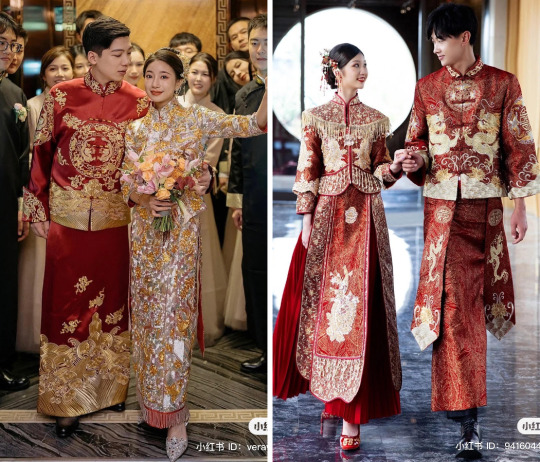
4. Modified hanfu (改良汉服/gailiang hanfu) and hanyuansu/汉元素 (hanfu-inspired fashion), which do not fit in the orthodox view of hanfu. Hanfu mixed with sartorial elements of other cultures also fit into this category (e.g. hanfu lolita). From the very start of the hanfu movement, there’s been debate between hanfu “traditionalists” and “reformists”, with most members being somewhere in the middle, and this discussion continues today. Below - hanyuansu outfits from 川黛 (left) and 远山乔 (right).

5. Performance costumes, such as Chinese opera costumes (戏服/xifu) and Chinese dance costumes. These costumes may or may not be considered hanfu depending on the specific style. Dance costumes, in particular, may have non-traditional alterations to make the garment easier to dance in. Dunhuang-style feitian (apsara) costumes, which I wrote about here, can also fit into this category. Below - left: Chinese opera costume (x), right: Chinese dance costume (x).
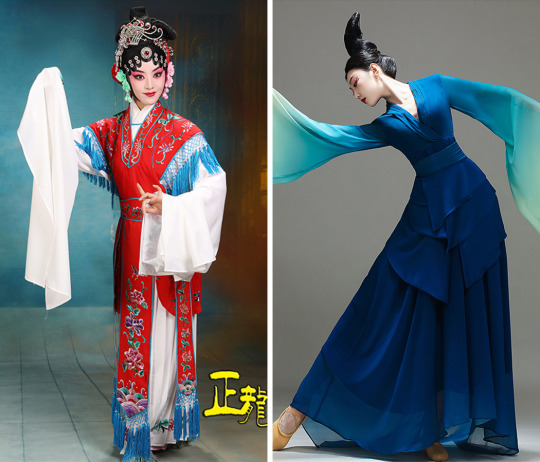
6. Period drama costumes and fantasy costumes in popular media (live-action & animation, games, etc.), commonly referred to as guzhuang/古装 (lit. “ancient costumes”). Chinese period drama costumes are of course based on hanfu, and may be considered hanfu if they are historically accurate enough. However, as I wrote about here, a lot of the time there are stylistic inaccuracies (some accidental, some intentional) that have become popularized and standardized over time (though this does seem to be improving in recent years). This is especially prevalent in the wuxia and xianxia genres. Similarly, animated shows & games often have characters dressed in “fantasy hanfu” that are essentially hanfu with stylistic modifications. Below - left: Princess Taiping in historical cdrama 大明宫词/Palace of Desire (x), right: Wei Wuxian and Lan Wangji in wuxia/xianxia cdrama 陈情令/The Untamed (x).

7. Any clothing in general that purposefully utilizes Chinese style elements (embroidery, fabrics, patterns, motifs, etc). Chinese fashion brand Heaven Gaia is a well-known example of this. Below - Chinese-inspired designs by Heaven Gaia (x).
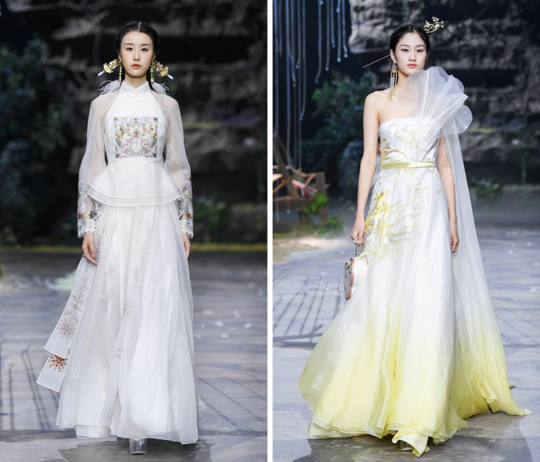
8. Technically, the clothing of China’s ethnic minorities also fit under the broad definition of huafu, but it’s rarely ever used in this way.
From personal observation, the term “huafu” is mainly used in the following situations:
1. Some large-scale events to promote Chinese clothing, such as the annual “华服日/Huafu Day”, will use “huafu” in their name for inclusivity.
2. For the same reason as above, Chinese clothing including hanfu will often be referred to as “huafu” on network television programs (ex: variety shows).
3. A few Chinese clothing shops on Taobao use “huafu” in their shop name. Two examples:
明镜华服/Mingjing Huafu - sells hanfu & hanyuansu.
花神妙华服/Huashenmiao Huafu - sells Qing dynasty-style clothing.
With the exception of the above, “huafu” is still very rarely used, especially compared to “hanfu”. It has such a broad definition that it’s just not needed in situations for which a more precise term already exists. However, I do think it’s useful as a short catch-all term for Chinese clothing that isn’t limited to the currently accepted definition of hanfu.
If anyone wants to add on or correct something, please feel free to do so! ^^
Hope this helps!
#happy 2023!#hanfu#huafu#terminology#language#hanfu movement#history#reference#ask#reply#>1000#chinese fashion#chinese culture#china
2K notes
·
View notes
Note
Do you have any suggestions on where to purchase vintage/reproduction/historically inspired menswear? This is often the first question I get when people find out I went to school for costume design, at which point I am forced to explain that my training... really does not cover that. At all. The shops I'm aware of make either costumes, or exclusively women's clothing, which seems rather unfair.
I'm tempted to just make some, but my program taught exclusively design and no construction. The end result is that I know exactly how a garment is made in theory, but in reality I'm still figuring out waistbands and closures.
I'm afraid I haven't a clue! I don't really buy clothes, aside from socks, shoes, and underwear. But I'll post this and maybe some of my followers will have suggestions.
It sucks that your program didn't teach sewing :( It's so important to have experience putting things together when you have to design those things.
(If you do want to make some, here's an obligatory link to my 18th century menswear resources post.)
177 notes
·
View notes
Photo
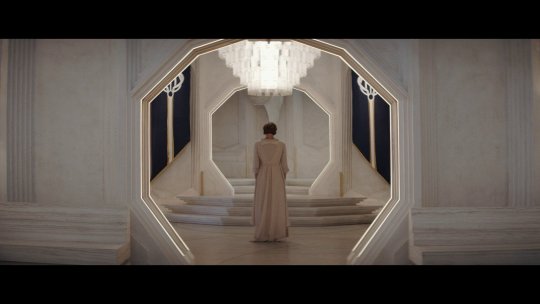
Okay, time to get pretentious and REALLY talk about this shot.

So put on your over-analysis goggles, and let’s talk about the Imperial Cog, Renaissance-era military forts, 18th century prison architecture, the military-industrial complex, the surveillance state, and why this single shot of Mon Mothma standing in a doorway in “Nobody’s Listening!” (the 9th episode of Andor season one) is making me so feral I want to kiss Luke Hull and his entire production design team right on the mouth.

For those of you not in the know - the shape on the screen behind Major Partagaz is the crest of the Galactic Empire - often called the Imperial Cog. It appears throughout Star Wars media on flags, tie fighter helmets, uniforms and as a glowing hologram outside ISB HQ.
In canon it was adapted from the crest of the Galactic Republic.
irl it was created by original trilogy costume designer John Mollo. Mollo has stated that the symbol was inspired by the shape of historical fortifications.

Bastion forts (aka star forts) first appear during the Renaissance with the advent of the cannon. Their shape eliminated blind spots, allowing for a 360 degree field of fire.
An apt metaphor for the Empire. Powerful, imposing and leaving you with nowhere to hide.
The Imperial crest also strongly resembles a gear or cog - hence the common “Imperial Cog” nickname.
Given how inextricably linked military and industry are, it’s also an apt metaphor. Both alluding to the Empire’s massive industrial power, and how it treats all of its citizens with a startling lack of humanity, valuing them only for what they are able to produce for the Empire.
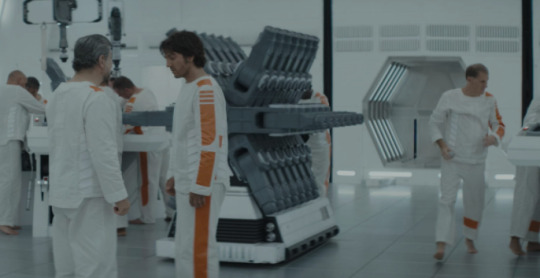
The idea of the cog is repeated in the shape of whatever it is that they’re producing in the prison. They’re literally cogs in the Imperial machine making more cogs for the machine... while inside a larger cog.

This shape, in relation to a prison, also references something else which was almost certainly intentional on the production team’s part.
In the 1791 British philosopher and social theorist Jeremy Bentham proposed a design for a prison he referred to as the “panopticon” - the name derived from the Greek word for “all seeing”.
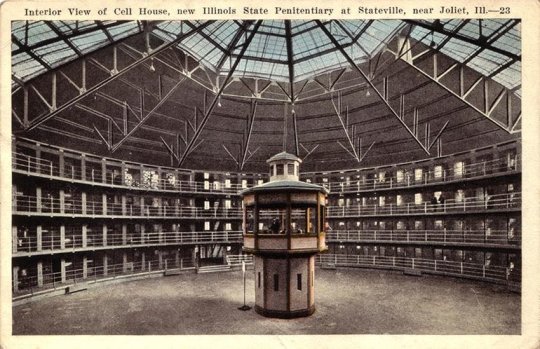
The basic design for the panopticon was a large circular rotunda of cells with a single watchtower in the center. The plan would allow a single guard to theoretically observe every cell in the prison, but more importantly cause the prisoners to believe they are under surevillance at all times, while never being certain.
Later philosophers (notably Michel Foucault) used the panopticon as a metaphor for social control under totalitarian regimes or surveillance states. The perceived constant surveillance of a panopticon causes prisoners to self-police due to the belief they are always being watched, even if they don’t know for certain that is true. They live in constant fear even if nobody is actually watching them, even if “Nobody’s Listening!”
The idea of the metaphorical panopticon has in more recent years been adapted to many other examples of social control: CCTV, social media and business management...
Like the concept of cubicles in an open floor plan office.

So that all being established - let’s finally talk about Mon Mothma’s apartment.
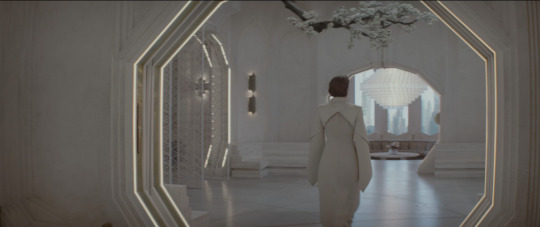
The cog shape is everywhere. There’s hardly a shot where at least one cog isn’t visible. Every room is connected by cog-shaped doorways.

The shape serves as a backdrop to most scenes, often centered and featured prominently.
(Side Note: The cog also appears as a repeated pattern on room dividers with the interesting added detail of intersecting lines that make them resemble spider webs.

The fact that Mon is often filmed directly through these web-like screens (particularly when conducting rebellion business) leads me to believe that this was a very intentional choice.
Even in the very heart of the Empire the nascent Rebellion is starting to build a web of networks and intelligence.)
I had originally presumed that the repeated appearance of the cog was just Luke Hull and his production team adding some brilliant visual storytelling to their already amazing sets. But the following line from episode ten leads me to believe they intended for these details to have an in-story explanation as well.
When speaking to Tay and Davo Skuldon about the apartment Mon states that “It’s state property. The rules are strict on decor. Our choices for change are limited.”
While it’s unclear whether the “state” in this instance is Mon’s home planet of Chandrila or the Empire itself - that second option makes the decor even more insidious.
If Mon’s apartment is Empire property that means the shape of the doors is intentional in-world, not just for the sake of visual storytelling. It means that this was a conscious decision by the Empire. A reminder to even the richest and most powerful of its citizens that they are always watching - whether you can see them or not.
Which brings us back to our original shot.

My favorite thing about this shot isn’t just that is shows how very alone Mon Mothma is.
It isn’t just that she’s in the heart of the Empire, surrounded and dwarfed - just another cog in their machine.
It isn’t just that’s she trapped in her own metaphorical prison, worrying her self sick about who may be watching, not safe even in her own home.
What makes this shot truly extraordinary to me, is that right in the midst of the Empire you can see a new symbol forming.
Forming with Mon Mothma right at the center.
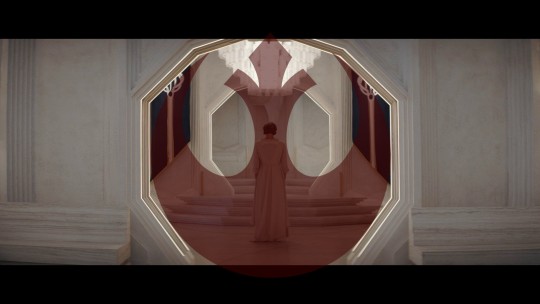
It’s a bit blocky, still constrained by the the harsh lines of the Empire, but giving how intentional every design decision on this show has been I find it pretty hard to believe it’s there by accident.
A symbol that will one day adorn the helmet of a boy from Tatooine.
One that will come to represent what all rebellions are built on...

#andor#andor spoilers#star wars#HOW IS THIS SHOW SO GOOD?#mon mothma#production design#history#long post#whose extensive knowledge of star wars and the history of the criminal justice system is useless now MOM
3K notes
·
View notes
Text


A few weekends ago, I went to Les Seigneuriales de Vaudreuil-Dorion with a friend. Since it's an annual historical Nouvelle-France fair, I wanted to create an outfit inspired by that time period (anything between the 16th and the 18th century). I sadly do not own any real historical recreation costume, so I did what I could with my own modern wardrobe.
Outfit rundown
Bonnet: Moi-même-Moitié (gift)
Overskirt: The Floral Notebook
Underskirt: second-hand Black Peace Now
Panniers: a gift from the designer of @british_wardrobe
Shirt: old gift from Boutique 1861
Belt, scarf and brooch: vintage
Boots: old Cobb Hill
#fashion#vintage fashion#vintage style#vintage#historybounding#historical fashion#17th century fashion#nouvelle-france#moi-même-moitié#moi-meme-moitie#goth fashion#gothic fashion#goth#second-hand fashion#fanny rosie#fannyrosie#ootd
424 notes
·
View notes
Text

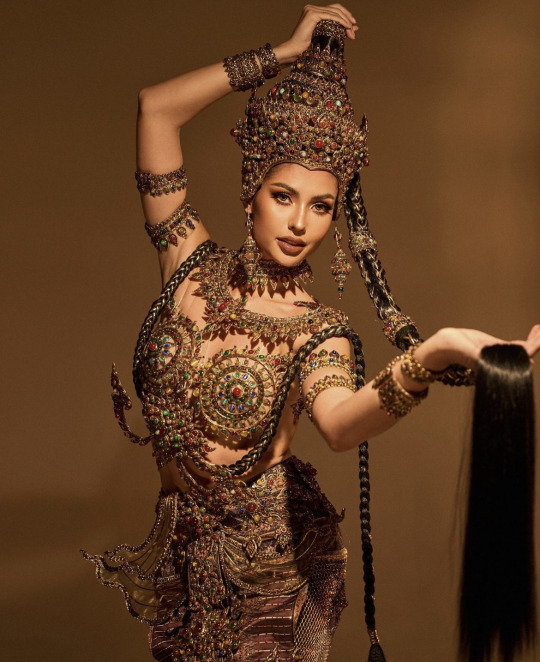






Miss Universe Thailand 2023 National Costume
The "Goddess of Ayothaya" costume draws inspiration from the graven image, "Phra Mae Thorani", during the late Ayothaya Dynasties of Siamese Kingdom existed during 14th to 18th century. "Phra Mae Thorani", the goddess of Earth or the Mother Nature in Buddhist Mythology is highly revered and worshipped throughout the Thai history. "Phra Mae Thorani" is usually depicted as a beautiful deity twisting her long hair tail producing the holy water, which eventually nourishes humankind with the water abundance. As "Thorani" means earth or land, it is believed that she resides in the land where she blesses humanity with fertility and abundance of nature. She symbolizes the significance of nature to human and embodies the protection of land and its richness of prosperity where Thai people hold dearly to their hearts. The dressing and accessories were constructed to resemble the graven image from Ayothaya Kingdom. The jewelry combines wirework with the use of colored stones and precious gems to align with actual recorded geological data from the period. And this is the pride of Nation, the symbol of richness in both culture and nature, the Goddess of Ayothaya.
213 notes
·
View notes
Text
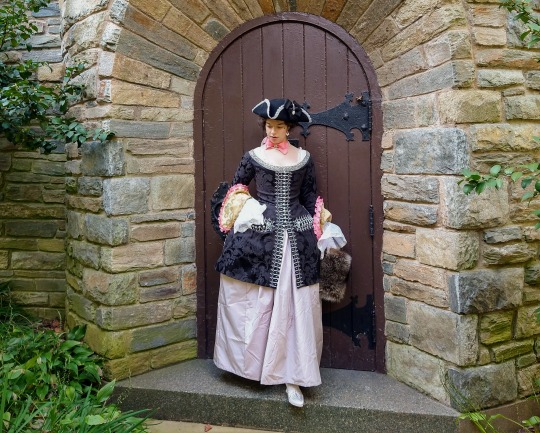
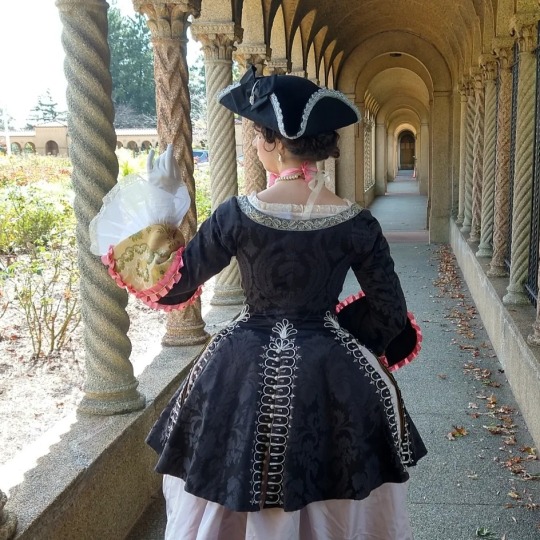
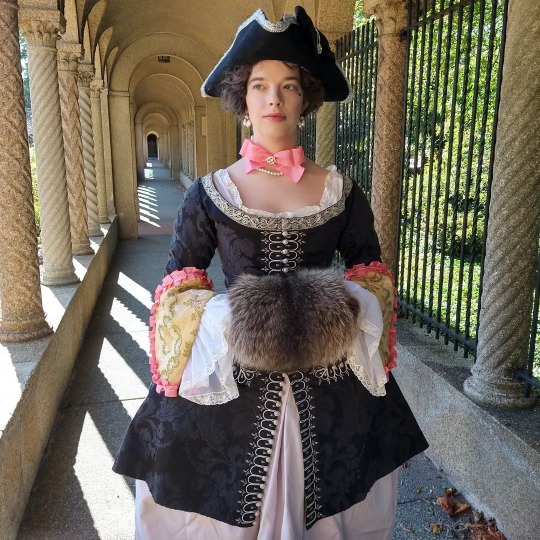
This jacket is the result of more than 2 and a half years of work, entirely handsewn! It represents the interest in equestrian and equestrian-inspired clothing as fashionable attire in Europe during the late 17th and into the 18th centuries.
I copied it from a jacket held by the Met Costume Institute, accession number 1981.314.2. When I emailed out to them for more information about the jacket, one of the collections people was even kind enough to pull it out of storage and take some detailed shots of the exterior AND interior (thanks Marci!!!)
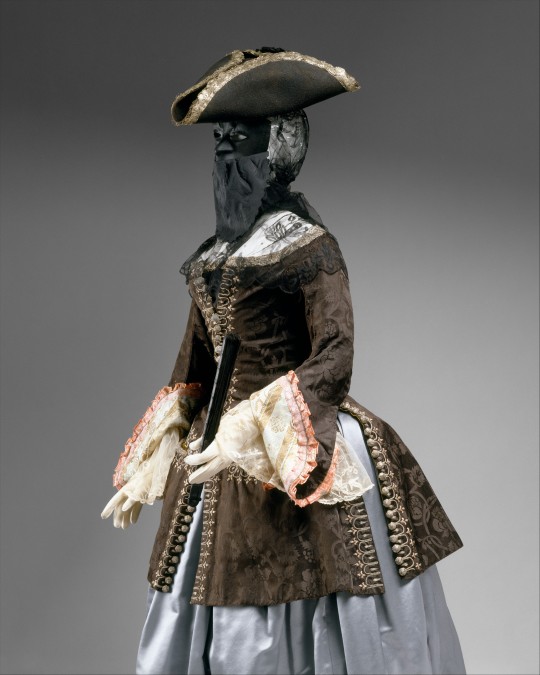
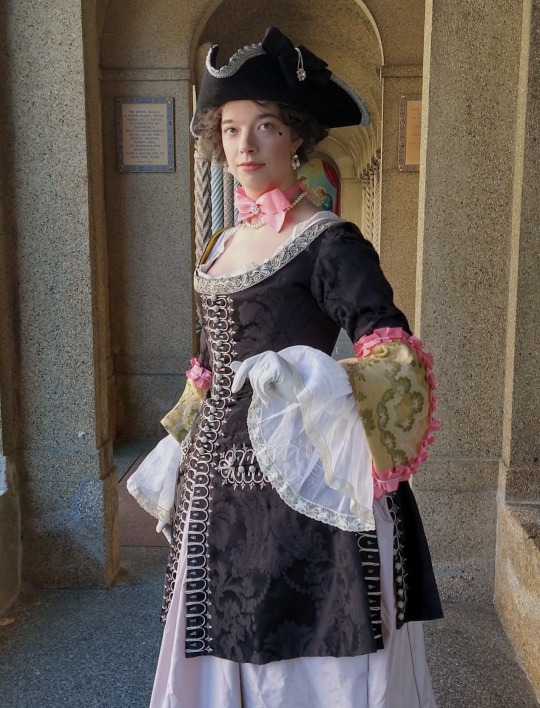
The Met dates it to the 2nd quarter of the 18th century which could be true--but there are several features of this jacket that could easily be dated earlier to the late 17th century, like the button size and layout. I plan to mull over this more in a later post. At least, I would definitely place it in the earlier end of that 1725-1750 range. However, I chose to style it for the 1730s/1740s because it's Fun For Me 🙂!
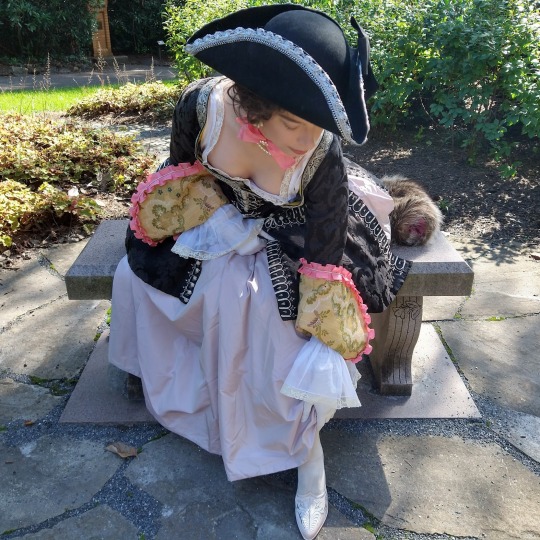
One of the most fun parts was gathering accessories to go with the jacket! I steamed a wool hat blank into the tricorn shape and applied the silver trim, made some detachable undersleeves based on paintings by Pietro Longhi, and threw together a matching neck ribbon as if I was some kind of ornamental poodle
#historical costuming#hand sewing#18th century#clothing reconstruction#riding habit#1720s#1730s#1740s#handsewn
82 notes
·
View notes
Text
Rhys Darby Improvised This Sweet Moment in 'Our Flag Means Death' Season 2
Costume designer Gypsy Taylor revealed how one coat prompted an unexpected moment of improv.

The Big Picture
Rhys Darby's performance as Stede Bonnet in Our Flag Means Death is both charming and funny, showcasing his comedic chops.
Costume designer Gypsy Taylor incorporated a funny and memorable moment into the show when Darby swished around in a new jacket during a fitting.
The costume design for Stede's Spanish-inspired outfit, featuring red velvet and a matador silhouette, brought out the fun and playful side of the character, allowing Darby to fully embrace the role.
Throughout his career, Rhys Darby has established himself as an actor and comedian to watch, bringing his own unique flair with every role he takes, including that of Stede Bonnet in Our Flag Means Death. The Max comedy recently premiered its second season, with Darby stepping back into the shoes of the Gentleman Pirate. Stede aims to be kinder than your stereotypical pirate, and thanks to Darby's performance, the character is a charming and funny one. In the recent pair of episodes, Darby has an especially memorable chance to flex his comedic chops.
During an interview with Collider's Carly Lane, costume designer Gypsy Taylor revealed a pre-production moment that made its way into the show. When Stede gets his hands on a new jacket, he swishes around in it. Ever the comedian, this was something Darby had done during the fitting for the jacket. Taylor said that it was such a funny moment, she wanted Darby to bring it to the screen. It was also a nice moment for Taylor because it meant that her work could continue to flourish in new ways.
"That’s what he was doing to me in the fitting room! I was like, 'Please do this on camera.' We were all just in fits of laughter. I like when I can add an element like that to give to a performer so that they can just take it to the next level. We go, 'Oh, wouldn’t that look cute? It might blow in the wind, or…' and then he instantly takes it on as this thing."
How Gypsy Taylor's Design Helped Spark the Hilarious Moment

Taylor also gave a bit of insight on the costume's design, sharing that she wanted to go for something Spanish inspired, as Stede raids a Spanish ship.
While the design lent itself to its inspiration and the era of the series, it was also just a fun costume for Darby: "We went red velvet and all the opulence. Then I kind of wanted this sort of matador silhouette so that you got this beautiful stance that comes, and these tight, high pants, and it’s all very fancy and dandy. Then we added an 18th-century moment with these big tails, which were just there for drama. But the minute Rhys put it on, he was like, 'Oh…' The tight pants made him stand up straight, and then his shoulders went back, and then he had the tails, he was spinning around the fitting room and flicking the tail. He was just having so much fun."
New episodes of Our Flag Means Death Season 2 release weekly in pairs every Thursday. The season finale airs on October 26.
Source: Collider
93 notes
·
View notes
Text
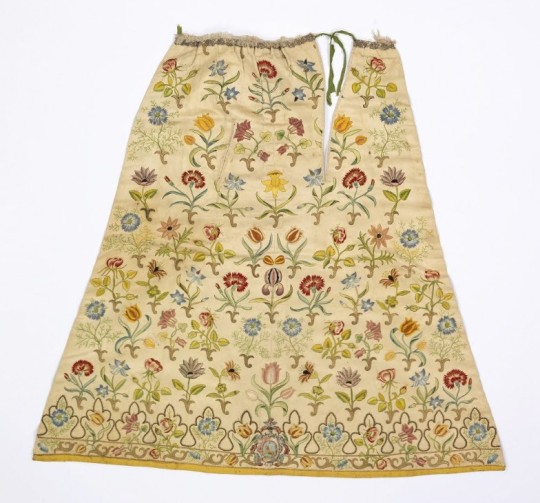
Skirt front, 18th century, France
#dianthus#carnation#inspiration#embroidery#flower pattern#flower ornament#18th century fashion#18th century costume
1 note
·
View note
Text
18th century inspired costume featuring back lacing stays. They are sewn mostly by machine, but the tabs are binded by hand and eyelets are also sewn by hand.
Also i feel like a character in Marie Antoinette movie from 2006 while wearing them hihi

Hair, makeup, model and photo by me<333
#historical reenactment#historical sewing#18th century#rococo#versailles#rococo fashion#18th century fashion#hand sewing#sewing#marie antoinette#historical costuming#18th century stays
92 notes
·
View notes
Note

By all means *eyes emoji*
Hi 👋
I took this ask as an invitation to figuratively dive into Richard's coat closet, and tried to compile every coat he wore in the last 30 years.
And oh boy, this man surely loves a good coat. He's the one member of this band who consecutively wore a coat on almost every tour and really takes a liking in the dramaturgical effect of wearing long (often times dark in color) coats and later reveiling additional outfits underneath, especially in later years. It fits his somewhat dramatic stage presence and he started quite early with these kind of stage outfits!
I subdevided this overview in two sub-topics to give this post somewhat of a structure, because this will be long.
1.) Richard's coats on stage (organized by year and tour)
1.1) Firstly, the plain black coat from the Herzeleid tour which he wore in 1995/1996. It's from what I could find the first time he wore a coat on stage while playing for Rammstein.

1.2) Addtionally, he wore the shiny red and silver coat during the Herzeleid tour as well as partly on the Sehnsucht tour in 1997. Same as the black coat before, he forwent any additional outfit underneath.

1.3) Also on the Sehnsucht tour, Richard wore the somewhat futuristic (reminded me a little bit of Star Treck costumes) black and silver coat which is clearly visible in Live aus Berlin. It suited the whole style of this era quite nicely and fit into the vibe of Till's cyborg/futuristic jacket as well.

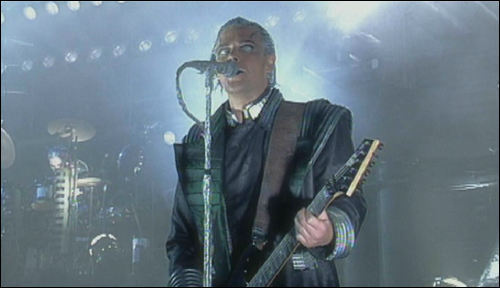
1.4) For his outfit during the Reise Reise tour in 2004/2005, Richard settled for a black military-style coat. The button rows seem to be reminiscent of french military uniforms from the 17th and 18th century (as well as the button lines and the embroidery on the collar of the underjacket) and his pants were designed in a similar style. The lining of the coat is bright red, a theme which would occur numerous times over the years.
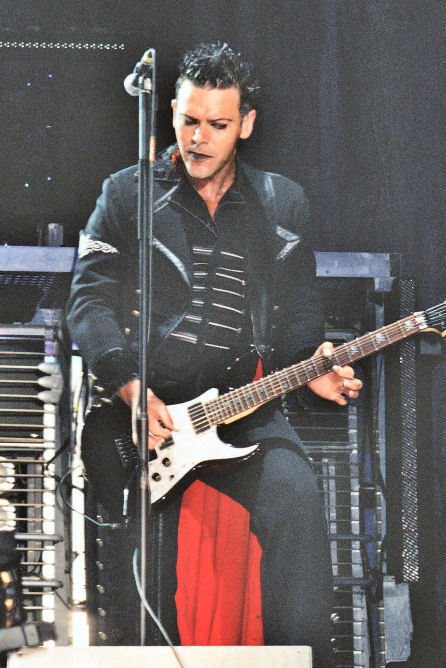

1.5) During the LIFAD tour, Richard wore a grey-mottled coat made out of a somewhat leathery material, adorned with silver buttons and a red armband - again he incorporated a red element in this coat, just like with the one before. On a sidenote: He once mentioned that Michael Jackson was an inspiration for this armband because Richard liked the cool look of it - his leg-belts (visible in the right picture) also kind of resemble the harness Michael wore on stage and in some videos during his Bad era.
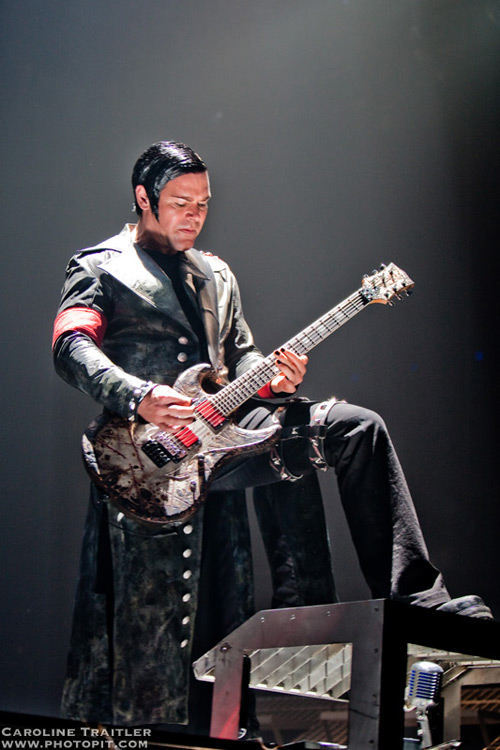
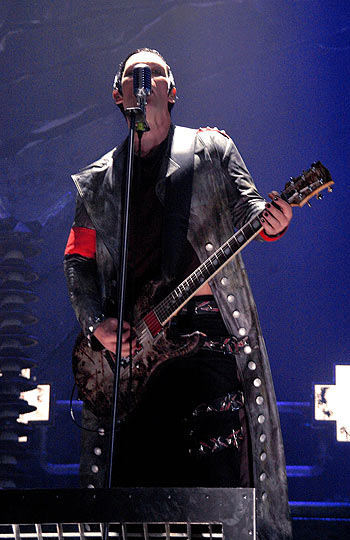
1.6) An absolute personal favourite of mine: The studded coat Richard chose for the 2013 part of the Made in Germany tour, oftentimes paired with the torn black and red top underneath. This one also got red lining, as well as a fine red line near the cuffs of the coat.
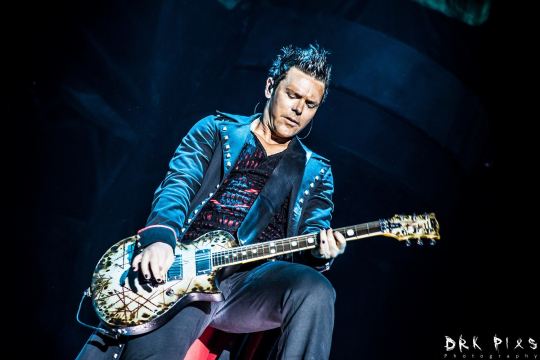
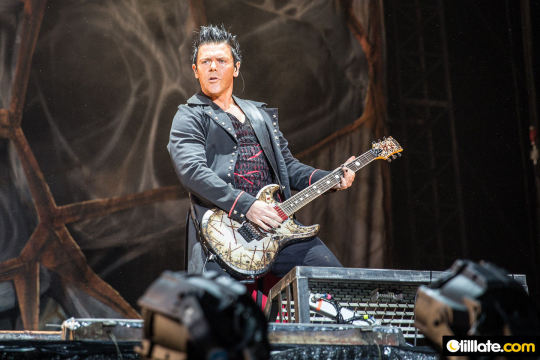
1.7) In 2016 for the Festival tour, Richard wore coat in a more cosy and snuggly style, which marked a break in the clean cut coat-aesthetic up to this point. It was more in the style of a cardigan with a zipper instead of buttons. The armband made a reappearance as the signature red element (mirrored by a red band on his pants), and red lines along the seams added this colourful accent.


1.8) For the 2019 tour leg of the Stadium tour, Richard mixed things up by wearing a two piece combo made out of a leathery material, with a studded cap on the right shoulder and red elements in form of the usual arm band and a red folding in the front. The lower part of this outfit was removable, so the upper part remained as a jacket.
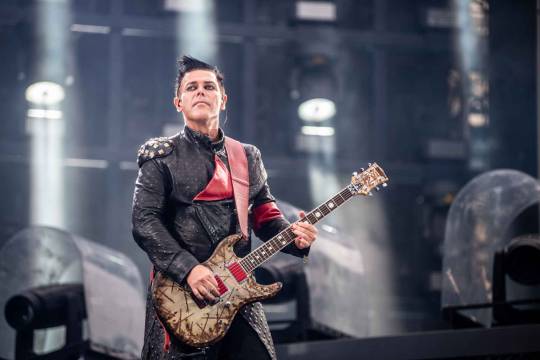

1.9) In 2022, he wore an all black coat with a belt and flaps along the shoulders, as well as snap fasteners as buttons; it overall resembled the typical look of a trenchcoat and seemed less rigid then the previous ensemble.
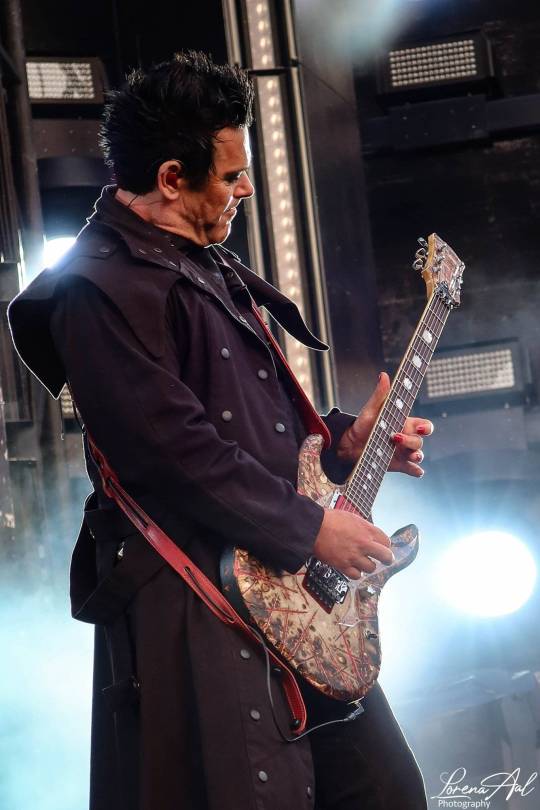

1.10) A true fandom favourite appeared on the scene in 2022 when he presented the infamous chicken coat. This one was already known from the "Freeze my mind" music video (from 2021) from Richard's side project and other band Emigrate. Different than in the music video, where a vest completed the look, Richard again after years went on stage without any outfit under it. This coat was used by him also during this year's tour leg.


1.11) Another personal favourite of mine is the black coat with red lining which he wore during this year's tour. Affectionatly dubbed "the vampire coat", this coat appears to be quite clean cut and simple, but has a very nice and dramatic effect on him (choosing gifs this time to underline this sentiment).

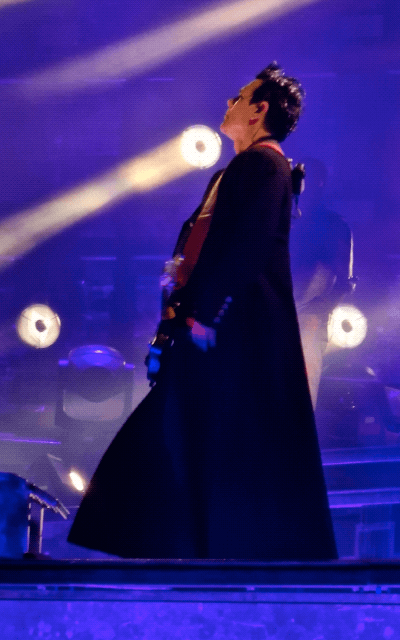
2.) Richard's coats off stage
Here are some of the coats Richard wore off stage during band fotoshoots and outings. Not counting normal jackets or parcas here.
2.1) The fur-lined coat during the Rosenrot fotoshooting:

2.2) The reoccuring black coat with fluffy fur elements, worn by him while being presented with awards in 2005 in Berlin as well as during the Echo award show in 2009:
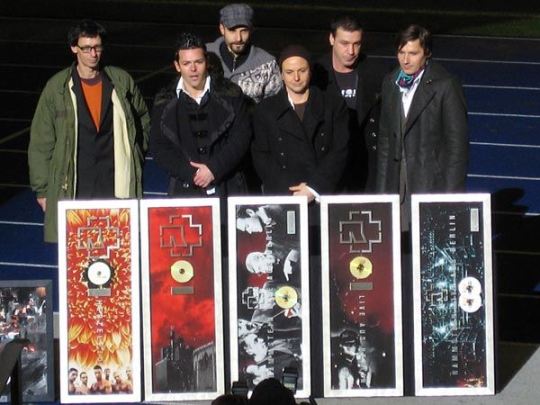

2.3) He wore another black coat which looked pretty similar to the one before but is still slightly different during a signing in Paris 2004:

2.4) And a brown/beige kind of trenchcoat was his style of choice for the Fashion rock night in 2009:
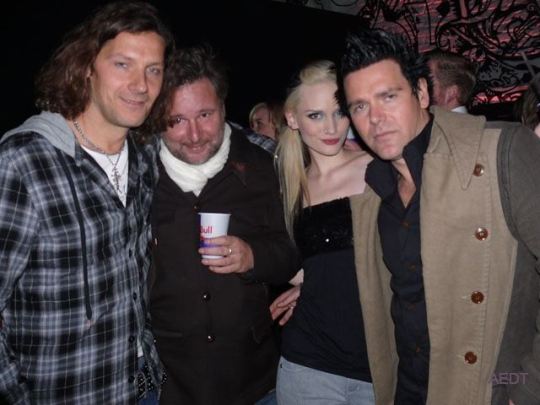
2.5) During the outdoor shooting for the LIFAD album, Richard wore another black coat:
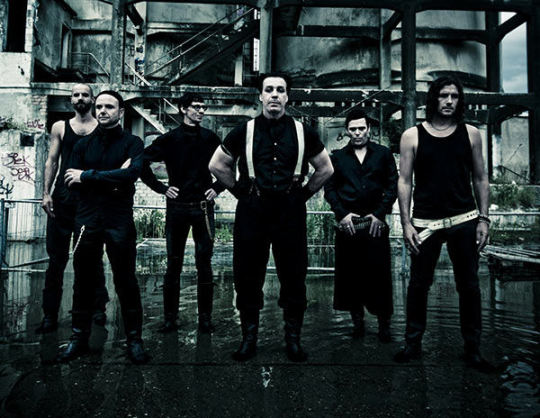

2.6) And lastly, the fancy embroidered coat Richard chose for promotion pictures for (I think) his first album with his band Emigrate:

Not sure if I was thouroughly enough and found every coat he ever wore, but I think the presented ones here really express his love for this piece of clothing in general 😊 I'm looking forward to either seeing a new coat on Richard next year or a return of his vampire coat 🦇 (Still hoping to see the studded coat someday again).
(Used picture sources: Rammwiki and the Rammsteinworld gallery - wonderful rabbit holes to get lost in.)
#rammstein#richard kruspe#richard's fashion lore#half his penthouse is filled with coats by this point i guess#this took me about 3 days to compile and i had so much fun no joke#thank you for this ask 💜#ask#richard's coats#emigrate
57 notes
·
View notes
Note
Someone in the notes on your post about food in fantasy mentioned connection between at least early modern production of sugar and colonialism and slavery, and while I 100% agree that it's something that should be known, I think that if you want to have lighthearted fantasy setting there are definitely ways to work around this.
Like sugar is also produced from sugar beet. I don't know could it be done without modern equipment (production started at the very end of 18th century so while industrial equipment was primitive it was), but like you may do something with it, like some wizards developing production technology.
In the same vein, crop exchange in the Old World was mostly peaceful, or at least it wasn't due to slavery. Like rice was already grown in Egypt in 1000 BCE and made its way to Spain by 7th century CE. Bananas were grown in Turkey by 15th century CE. And tons of agricultural goods come from West Asia both ways. What I am trying to say is that if your world has equivalent of Americas your Europeans* could have just acquired potatoes and corn without colonization (because they were more ethical than irl or because they didn't have resources for conquest or because American nations were strong enough to stop them). Like potatoes and such are just crops, sailors could have picked them as a supplies and then someone decided to grow them at home.
This is like a suggestion specifically if you want to have a world for costume drama without dealing with heavy themes. I would suggest describing it specifically to point that out, and I can't say that it's very politically aware but definitely not worse than "they just have it" or "yes there are overseas colonies but pay it no mind".
*Because that's usually the case in examples that are discussed, from what I heard East Asian fantasy set in East Asia also suffers from this for the same reason, but I didn't read enough of it to say
Let me say you make real good points and I broadly agree with you. I do think the history of colonialism and where our foods came from is important (I do research that so no doubt). And I also agree that sometimes, those themes are too difficult to board properly, especially in a lighthearted story.
However, in fiction, it's not so much that I want people to do more "clean" ways of getting those crops. Many people told me "well, what if they get it through trade, or what if they got it through magical portals and such" my point is not that you find a "colonialist free" way to have potatoes in your setting, my point is that every crop in real life has a history behind them, and when you place them in your setting, I think you should consider that. Not only because you will learn about real life and its history, but also because of the storytelling potential.
I mean, I do have "worldbuilding fundamentalist" in my bio, and I think even if you don't sketch the entire world, you should at least know where your heroes are. Much of modern fantasy loves to adopt the "medieval" aesthetic, while in fact presenting a world with widespread trade, urbanization, a growing artisan class, etc. (I've done a longer rant about it here). Those things aren't just aesthetic choices, they are different societies that have different dynamics and they do affect the kind of plots and characters you might make on them.
I don't think fantasy should shy away from exploring themes such as imperialism and colonialism, trade and politics, intercultural contact and social change. One reason why I'm so insistent with the theme of crops and trade is that it's because it's emblematic of those issues. Sure, you don't want to explain the potatoes or chocolate in your setting, whatever. Don't you WANT to, though? Don't you want to explore beyond the pseudo-medieval aesthetic, and explore what an American or African -inspired setting might look like? Of course, you could and should also make your own new settings, but exploring actual history, geography, biology (at the broadest term, natural history) will make you a better worldbuilder and a better writer, AND also let you learn more about the world.
Sorry if this rant is a bit unfocused, just woke up from a nap after some wine, but this is why I'm so insistent with the stories that can arise just by considering the crops in your setting. Imagine what else can you write.
26 notes
·
View notes
Note
Imagine taking Philip/Belos to your local Renaissance faire.
I know I took a little too long to answer this, but I genuinely had no idea how to answer it until now! I've never been to a Renaissance Faire, and everything I've seen/heard about them have been through other people, so sorry if this isn't completely accurate!
Many people said that folks like to dress up as elves/witches when they go to Ren Faires. Lots of fairycore going on! Someone I talked to mentioned that he might mistake these costumes for actual witch endorsement and be confused/angry. They mentioned that he may feel more at home at Colonial Williamsburg since that would be more up his alley. It's more of an educational excursion than it is a theme park/fair, but something tells me he would absolutely adore being in a place like that. I had to go on the Colonial Williamsburg website to see what all they had since I had never heard of this before, and I can imagine Philip/Belos never wanting to leave!
Getting to see historic sites of a time that more resembles the one he came from is sure to both make him feel a twinge of homesickness as well as a swell of pride that the home he once knew has not been forgotten by time.
There are carriage rides, strolls through the gardens, educational guides, 18th-century-inspired taverns that have fully colonial-style menus, and markets range from produce stands, pottery shops, and even bookstores that keep to the whole 18th-century colonial theme. It really is very interesting…
Not to mention that THIS is what a room at one of the CW lodges looks like. Philip would be in fucking heaven.

He'd sit in the gardens for HOURS. He'd help feed and pet the horses. He'd want to enter every shop, even if he didn't buy anything. He'd take his journal and write about everything he learned about at the historic sites. He'd actually relax at a tavern and drink before retiring to his room for the night.
He might actually want to never leave.
Sorry if this entire post was me gushing about CW instead of Philip xD I only just learned about this place when I was researching for the ask and its soooo fascinating!!
#philip wittebane#toh philip#belosfanstakeover#toh#toh emperor belos#emperor belos#belos wittebane#the owl house belos#toh belos
26 notes
·
View notes